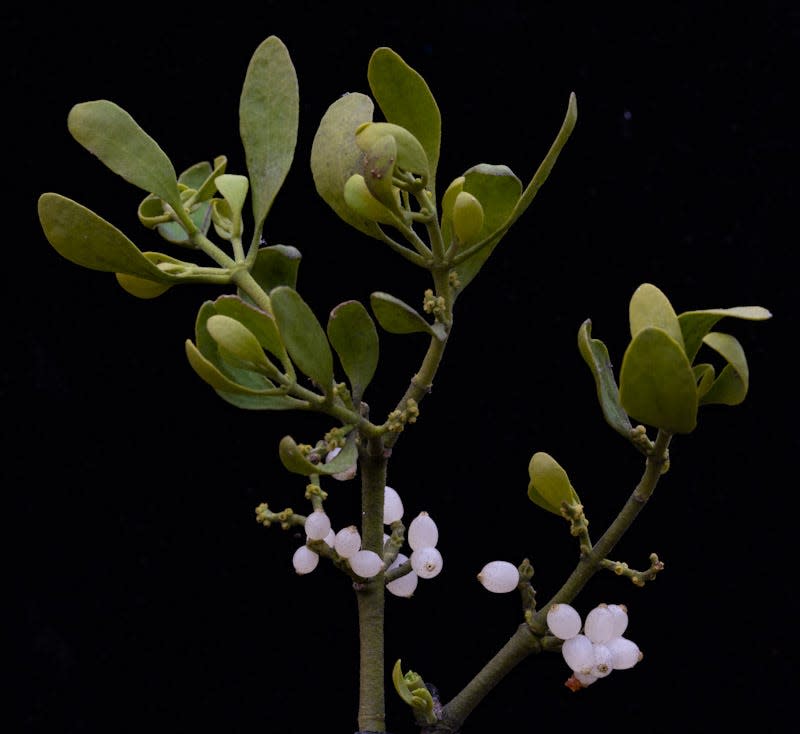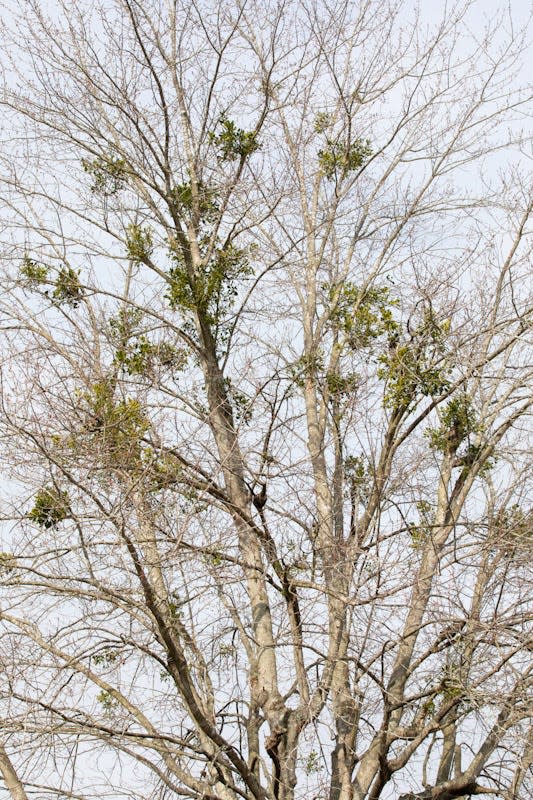Mistletoe more than just a holiday decoration for kissing under

If you believe in the kissing legend, and hope to get a buss, visit the little town of Chesapeake in Lawrence County. There, hard on the banks of the Ohio River and about as far south as one can get in Ohio, American mistletoe grows wild in the boughs of silver maples, elms and other trees. Stand under such a tree and maybe you’ll get lucky. Or hauled off by the sheriff.
While the kissing/Christmas decor/mistletoe tie-in originated with the similar European mistletoe (Viscum album), in this country, American mistletoe has taken up the banner.
More about mistletoe:Why do we kiss underneath a parasite? The origins of mistletoe explained
I recently visited the little burg of Chesapeake, and photographing mistletoe was a priority. The epiphytic plant is easy to see, as it forms large roundish clusters that resemble poorly constructed bird or squirrel nests. Favored host trees might have 10 or 20 clumps, and the largest are bigger than a basketball.
While there are nearly 600 species of mistletoe worldwide, only 15 occur in North America and only one of those is found in Ohio. American mistletoe (Phoradendron leucarpum), ranges widely throughout the eastern U.S. and west to California and Oregon. Its northern limits are on the Ohio side of the Ohio River Valley.
While on occasion I have seen rogue plants perhaps 20-30 miles north of the Ohio River, virtually all our mistletoe grows within sight of the Ohio River. It ranges from Cincinnati to Marietta, with Adams and Lawrence counties being hotspots.
Unlike some parasitic plants, mistletoe photosynthesizes and is quite green, even at Christmas. It derives nutrients from its host trees by way of specialized roots called haustoria. These tough structures penetrate into the tree’s conductive tissue and extract water and nutrients.
How do mistletoe plants attain lofty perches in trees? Birds. The odd plant flowers in late fall and into winter, and hardly anyone notices the small spikes of tiny green flowers. But by this time of year, the fruit begin to mature and the showy pearl-white berries are far more conspicuous. Flashy fruit is a plant’s way of flagging down the feathered crowd. Birds make excellent seed dispersers as their extreme mobility spreads seeds far and wide.
Cats' comeback:Bobcats' return to Ohio's forests an environmental success story
American robins, cedar waxwings, eastern bluebirds and other fruit-eaters spread mistletoe via their droppings. Seed-laden guano that lands on a tree branch germinates a new mistletoe plant. Technically a shrub, the woody-stemmed mistletoe can live for decades. Other than harvesting by zealous Christmas decorators or those desperate for a kiss, the collapse of the host tree is probably mistletoe’s greatest threat.

I can report that making mistletoe photos is not necessarily easy. Shooting the clumps in the trees from afar is child’s play. Just stand in a good spot and fire away. Getting close-up images of the fruit and flowers is another matter. Very rarely does mistletoe grow within arm’s reach of the ground, and despite much searching around Chesapeake and vicinity, I could find no low-growing plants.
There is also the matter of private property, upon which most mistletoe grows. One should always be mindful of trespassing issues – especially in southern Lawrence County. Finally, I drove by an assisted-living facility and voila! A couple of crabapples in the front lawn had luxuriant clumps within 15 feet of the ground. The very nice lady at the desk, bemused by my odd request, granted permission to ascend a tree.
Fortunately, I had packed a ladder, anticipating the need to go aloft, and soon had a fine specimen for photography (I guess botanists can be added to the list of mistletoe threats).
Happy holidays, and as they say: What happens under the mistletoe stays under the mistletoe.
Naturalist Jim McCormac writes a column for The Dispatch on the first, third and fifth Sundays of the month. He also writes about nature at www.jimmccormac.blogspot.com.
This article originally appeared on The Columbus Dispatch: Mistletoe berries attract birds that spread seeds far and wide

